by Marcela M. | May 2, 2013 | cookies, Recipe Box, Recipes, Sweets

Good evening dear friends!
I am writing today’s post from Belgrade, Serbia, where we are currently visiting my husband’s family. Cyprus follows the Orthodox calendar, according to which Easter falls on May 5th this year, so we are taking advantage of Luka and Zoe’s brief break from school for a short family trip. I will tell you all about it when I get back home!
These truffles, which are ridiculously easy to make and are full of food that is good for our bodies, were made before I left and devoured by my family. If you read the two last posts, you already know that my children are picky eaters and that I keep looking for ideas to get them to eat food that tastes delicious but that also provides them with the nutrients they need in order to grow up healthy, food that helps them thrive.
These little balls of goodness may do just that. I came up with them while playing in the kitchen, trying to recreate my favorite store-bought nut bars (which are way too expensive for me to buy them too often). I looked at the list of ingredients in the package, figured out the percentages that seemed more accurate to me, added a few super foods and decided to try the method that I detail below. I
considered for a while whether it would be better to soak nuts and dates before hand, but didn’t, even though I will probably try that method in the future as well, at least to compare which one I like best.

These truffles are ideal to make with kids, because of their simplicity. If you don’t like any of the ingredients, feel free to replace it for something similar (I do that all the time). And did I mention that they have no added sugar?
Do you want to try them now?
Here is the recipe:
Raw vegan truffles with dates, nuts and berries (makes around 40)
Ingredients: 250 grs dates, 160 grs cashews, 100 grs currants or raisins, 15 grs goji berries, 15 grs dried cranberries, 1 tablespoon chia seeds, 3 tablespoons water,shredded coconut for rolling the truffles in it (optional)
Preparation.
1) Put the cashews in the bowl of a food processor and pulse until they turn into flour.
2) Add the pitted dates, currants or raisins, berries, chia seeds and water. Process until you get a dough that separates from the sides of the bowl.
3) Put the dough in an airtight container and put it in the refrigerator for 1/2 hour.
4) Remove from the refrigerator. Take small pieces of dough with a teaspoon and form them into balls. You may then roll the balls on shredded coconut, as in the pictures, or leave them without. It’s your choice.
5) Keep stored in an airtight container, in the refrigerator, for up to a week.
Have you ever made raw truffles or cookies before? Please share in the comments below!

by Marcela M. | Apr 4, 2013 | Blog, cookies, Recipe Box, Recipes, Sweets
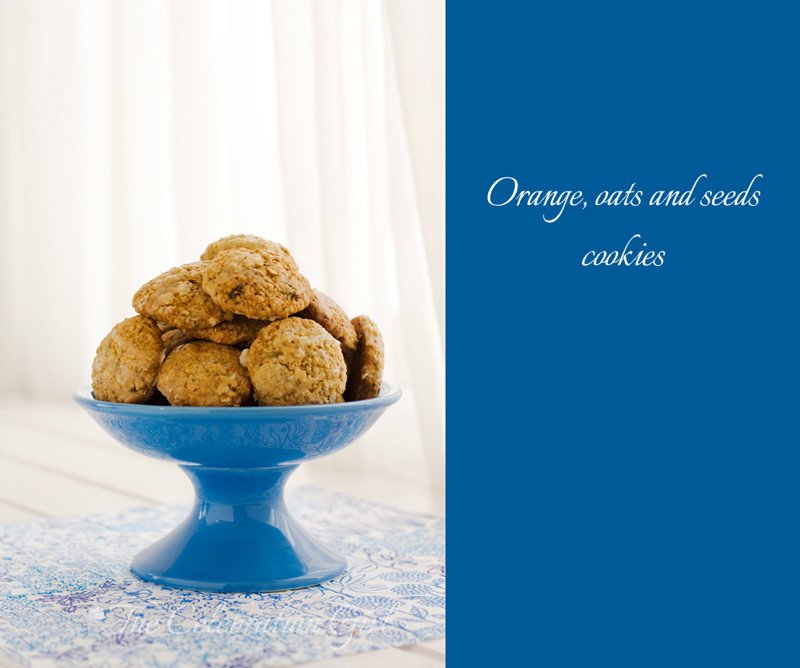
Good morning dear friends!
I’m very happy today, because yesterday I sent out my first newsletter!!! I got great feedback from some subscribers and that had me smiling all day long. Thank you for being there! If you forgot to subscribe but would still like to read the newsletter, I can still send it to you, all you have to do is register in the pink form on the sidebar or in the one at the end of this post!
Now let’s move to today’s recipe, which was my monthly contribution to Petit-On. As you know the recipes contributed have to share one common ingredient, and the one for March was oranges.

I love oranges. I use them a lot in my baking and also when cooking savory dishes (like tangerine beef, or orange scented quinoa, for example). I adore how just a tiny bit of orange zest can completely transform traditional dishes, such as pastry cream or strawberry sauce.
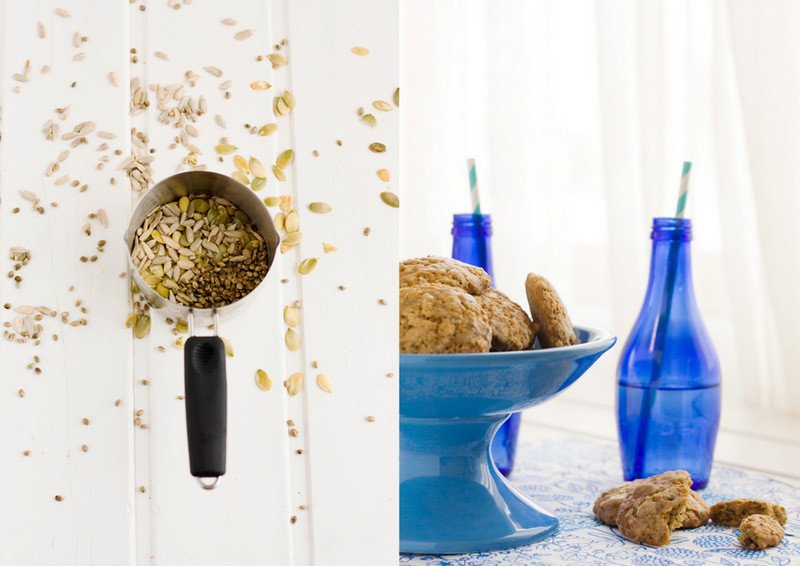
I adapted this recipe from one given to me by my mum, a few years ago. The original one used self-raising flour and did not require any baking powder nor baking soda or cornstarch, but I modified this because I was unable to reproduce it with the flours that I could find in Cyprus. Self raising flours in Argentina do not require any leavening agents as do, from my experience, the ones sold in Europe so, after a couple of culinary disasters, I made a few modifications to preserve the cookie’s yumminess. I also reduced the original amount of sugar and used different seeds because the ones I used to include in my native Córdoba (such as Amaranth) cost a fortune here. This is one of the best things of this recipe: it is very versatile. If you keep the proportions more or less intact, they will definitely turn out tasty and be a success! And they are dairy free!
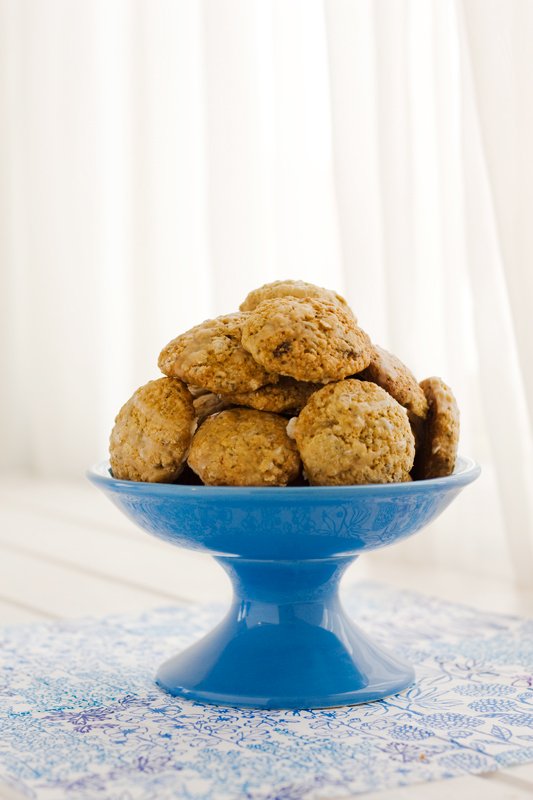
Here is the recipe
Orange, seeds and oat cookies (makes 3 dozen)
Ingredients: 2 cups rolled oats (I use Quaker), 1 cup all purpose flour, 1/2 teaspoon baking of soda, 1 teaspoon baking powder, ½ cup cornstarch, 3/4 cup of sugar (I used golden) 3/4 cup oil (canola or sunflower), zest of 2 oranges (you may also use lemon or clementines, or a combination) , 2 eggs (M), slightly beaten, juice of half an orange, 1 cup of mixed seeds ( I used 2 tablespoons of chia seeds, 2 tablespoons of hemp seeds, 2 tablespoons of pumpkin seeds and 3 tablespoons of sunflower seeds) .
NOTE: You may also use other seeds, such as sesame, linseed amaranth, poppy, etc. You can also use only 1/2 cup of seeds and add 1/2 cup of raisins, dried berries, or nuts, if you wish. If you add fruits or nuts, just remember to toss them in flour before adding them to the batter.
Preparation:
1) In a bowl, mix flour, baking soda, baking powder, sugar, cornstarch and oats.
2) Add oil, eggs, and orange juice and zest and mix to incorporate well.
3) Add seeds and mix briefly. Be very careful not to over mix or the cookies will turn out hard. Beware that the dough will look very soft and you may be tempted to add liquid, but DON’T. All you have to do is wrap it in foil and place it in the refrigerator for at least 2 hours. You can also freeze the dough and bake the cookies later. If you don’t want to wait, you may bake the cookies but keep in mind that they won’t keep their shape.
5) Remove the dough from the refrigerator, extend it with a rolling a cut, using traditional cookie cutters. Place the cookies on a baking sheet lined with baking paper and bake at 175 degrees/350F until golden (approximately 15 minutes, but this depends on each oven). Keep in mind that these cookies do grow in the oven, so leave space between them when you are placing them in the baking sheet.
6) When they are ready, remove them from the oven and let them rest on the sheet for about 10 minutes. After this, remove them with a spatula and place them on a wire rack until cold (or eat them warm, I won’t tell anyone 😉
I hope you like this recipe and , if you do, please share it!
Now, please tell me in the comments below: which is your all time favorite cookie?
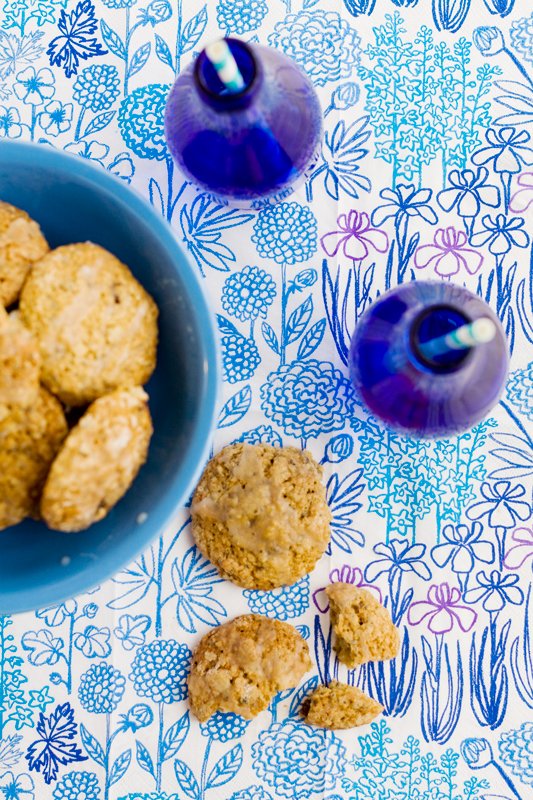
Para ver la receta en español, HACER CLICK AQUI
by Marcela M. | Jan 25, 2013 | Blog, cookies, Recipe Box, Recipes, Sweets
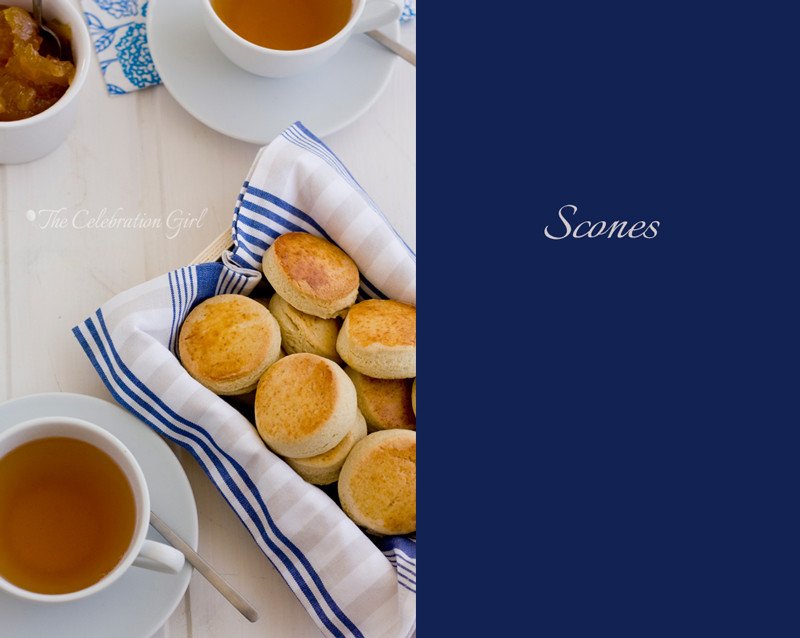
Good afternoon dear friends! I hope you had a wonderful start of the New Year. I missed you these past days!
I hadn’t planned to take a break from blogging but, as you may know if you follow me on facebook , my children and I were hit hard by weather and, for the first time in years, I couldn’t lift a finger. It all started on Christmas day, when I lost my voice (a serious tragedy for a chatter like me, maybe not so much for my family ;). 10 days later, my daughter woke up with high fever, and Luka and I followed her a day after, with 40C. When, after a couple of days, the fever didn’t recede, we took the children to see the doctor, who also checked me. Luka and Zoe had what appeared to be just a flu but later developed into a ear infection requiring a full course of antibiotics and I, myself, had tonsillitis- so antibiotics were prescribed for me as well. Then, this week, just after we had finished her course of antibiotics, Zoe relapsed with 48 hs of non-stop cough and high fever and then, almost miraculously, her cough and her fever stopped, as suddenly as they had started. Now Luka seems to have caught the same virus and started having fever. Ahh, the joys of Winter…oh well.
Over the years since Luka and Zoe were born, there have been many minor health problems and a few scares as well, but this was the first time (since recovering from the cesarian) when I was not feeling well myself either when taking care of their own ailments. I don’t normally get ill, and entire winters go by without me catching a single cold (which I attribute to the ridiculous amounts of garlic I consume. Seriously, I’m sure Dracula has marked my house as a no-go area!). To be honest, I hate being sick and I’m not very good at it because I just.can’t .stay. in. bed. and when I absolutely have to, I am making mental lists of things I have to do the minute I am able to stand up and get going. So this period of common illnesses was a challenge for me, and all the more so because my husband was away from Cyprus this last week.
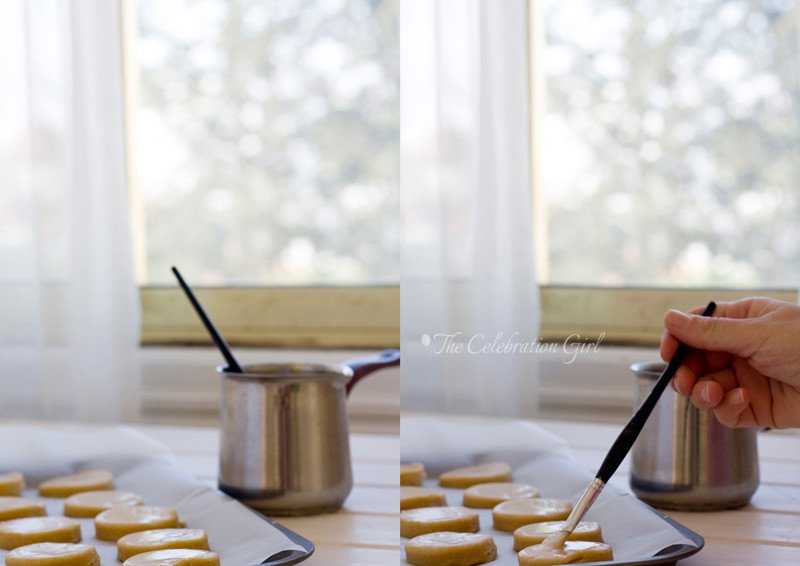
One of the things that was on my mental “to do”list while I was trying hard to lie in bed were these scones, Whole Kitchen Magazine’s January challenge. When I saw the recipe that was suggested for this month I was so happy! I love scones, they were always one of my favorite treats when I was growing up.I like them because they are not too sweet, and they admit so many variations that the possibilities for getting creative with them in the kitchen are almost endless. We can even get the same recipe and make them savory, with spices such as garlic and thyme, or rosemary, to accompany a hearty Winter soup.
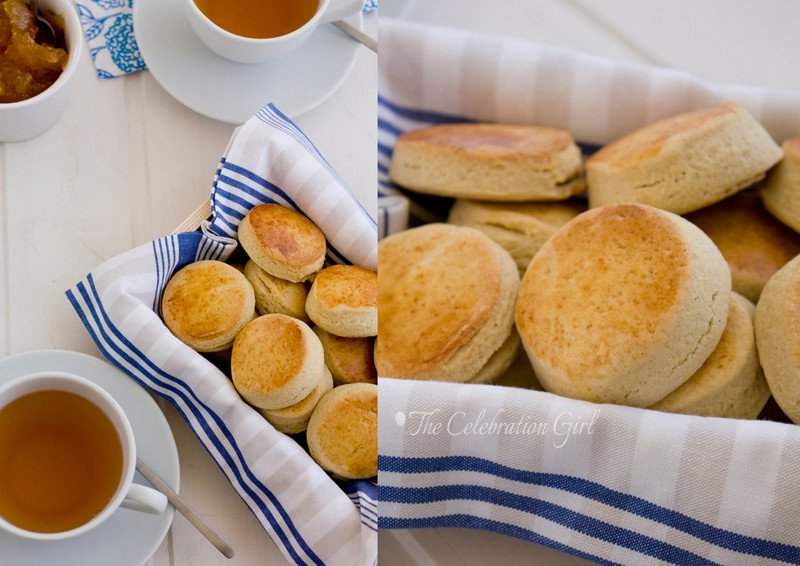
It is for this reason that I opted to make a a traditional, plain vanilla recipe without glaze. I wanted to give you the basic recipe so as to allow for experimentation. I’ll show you some of my favorite variations in the future but, for now, I thought it would be nice to start small.
As you will see from the recipe, the procedure is fairly simple, but there are a couple of important steps to get them right: 1) Don’t over mix the batter, and don’t knead the dough. This is crucial. You should barely integrate the dry ingredients into the wet ingredients and then roll and fold no more than 3 times. If you have remaining dough after the first cut, roll once only and cut again. 2) Make sure to pre-heat the oven properly, so that you can pop them in the oven the minute they are ready, or otherwise they won’t rise properly. You can see the difference between the ones that were placed in the oven immediately and the ones that had to wait on the counter in the next picture. They still taste fine, but the texture is different. So, if you want perfect scones, make sure the oven is hot and ready and don’t waste time!
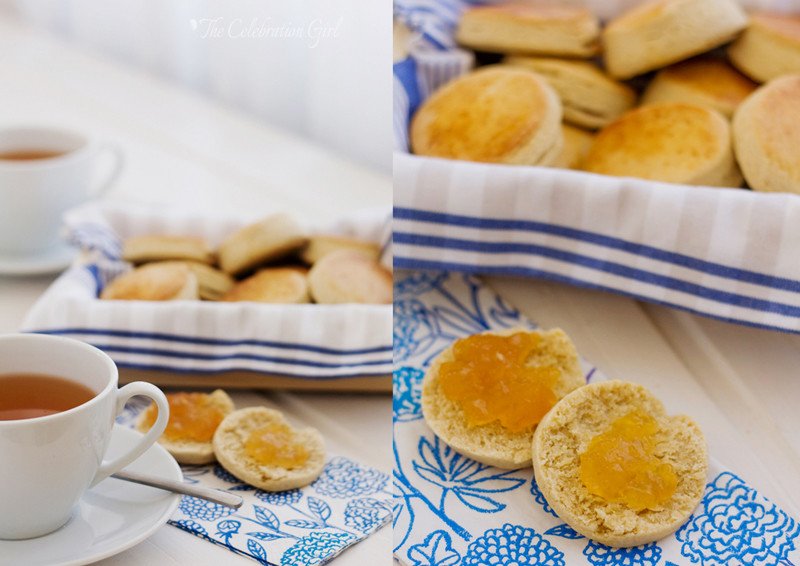
I like to eat them with jam ( some people also use clotted cream) and to accompany them with some nice tea. If shared with friends and loved ones, they taste better, of course 🙂
Now, one last important piece of information before leaving you with the recipe: Luka and Zoe’s baby sitter, who is an adorable Scottish lady, has asked me to request you to pronounce their name the ways Scots do, as if the E was not there (scons). She says English people pronounce them differently but that, since they are a Scottish treat and not an English one, she feels very strongly that they should be pronounced the Scottish way. So now you know 🙂
Here is the recipe:
Scones (makes around 30)
Ingredients: 500 grs all purpose flour, 2 teaspoons baking powder, 150 grs butter, 150 grs icing sugar, 3 egg yolks, 1 tablespoon vanilla extract, 125 cm3 warm milk + 1 egg yolk and 20 cm3 milk for brushing them before putting them in the oven.
Preparation:
1) Pre-heat the oven to 200C. Mix flour and baking powder and sift together over the counter. Make a well in the middle.
2) Add butter (softened at room temperature) and sift the icing sugar on top of it. Mix with your hands until creamy.
3) Add the egg yolks one, by one, and cream with your hands after each addition.
4) Add vanilla extract and milk. Mix until incorporated.
5) Fold the flour into the wet ingredients until fully integrated, without kneading.
6) Dust the countertop with flour and roll the dough to form a rectangle. Fold the dough in the middle and roll again. Fold and roll two more times, without leaving resting periods and then roll one final time, until getting a width of approximately 3cms.
7) Cut circles using a round cookie cutter and place the scones on a baking tray lined with baking paper.
8) Mix one egg yolk with 20 cm3 of milk and brush the scones with the mixture. Place the baking tray in the hot oven for 30/35 minutes (they will get golden on top).
9) Remove from the oven and place on a wire rack to cool completely.
Con sabor latino…
No había pensado tomarme vacaciones del blog pero, como seguramente sabrán si me siguen en facebook, mis hijos y yo caimos víctimas de unos virus fuertísimos y, por primera vez en muchos años, no podía ni moverme, mucho menos sentarme a la computadora, o sacar fotos. Todo comenzó el día de navidad, cuando me desperté sin nada, nada, nada de voz (lo que para alguien como yo es una tragedia aunque, posiblemente, para mi familia haya sido una bendición 😉 10 días más tarde mi hija empezó con fiebre, y 48 horas más tarde le seguimos Luka y yo, con temperaturas que llegaban a los 40 grados. Seguimos así un par de días, así que llevamos a los chicos a la pediatra, que me revisó a mí también de paso. Luka y Zoe tenían lo que parecía ser sólo una gripe pero luego derivó en una infección en el oído, y yo tenía amigdalitis, así que terminamos todos con antibioticos. Luego, esta semana que acaba de terminar, cuando apenas habíamos terminado el ciclo de antibióticos, Zoe cayó en cama nuevamente con 48 hs de fiebre y una tos terrible y constante y que cesaron tan abruptamente como habían comenzado. Eso sí, ahora parece que Luka está empezando con lo mismo…ahhh las bondades del invierno…qué se le va a hacer.Esta no es la primera vez que mis hijos están enfermos, claro está. Pero esta es la primera vez que yo he estado enferma al mismo tiempo. Por suerte, no suelo enfermarme nunca y normalmente el invierno pasa sin que yo me agarre ni un resfrío (lo que atribuyo a las enormes cantidades de ajo que consumo. En serio, yo creo que Drácula debe tener mi casa marcada para que los vampiros no se acerquen ni por casualidad). Quizás a causa de esto, detesto estar enferma y soy mala paciente porque no.puedo.quedarme.en.cama. y cuando no tengo más remedio que hacerlo me la paso haciendo listas mentales de cosas que quiero hacer ni bien pueda levantarme. Así que, como imaginarán, este período de enfermedades conjuntas fue un desafío para mí, más aún porque mi marido estuvo de viaje fuera de Chipre durante toda la semana pasada.Una de las cosas que estaba en mi lista mental de cosas para hacer cuando me sintiera mejor, eran estos scones que Whole Kitchen Magazine nos proponía a los miembros del círculo para el mes de enero. Me encantan los scones y han sido, desde siempre, una de mis galletitas preferidas. Me gustan porque no son demasiado dulces y porque admiten tantas variaciones que es facil ser creativo y experimentar con ellos, pudiendo incluso eliminar el azucar y hacerlos salados, con especias, para acompañar una rica sopa. Es por ello que la receta que les traigo hoy es muy simple: scones de vainilla sin baño alguno, porque quería darles la receta básica para que ustedes mismos puedan jugar con ellos de la manera que mejor les plazca, intercambiando sabores y agregando ingredientes si asi lo desean.Hacer scones es muy sencillo, pero deben observar dos reglas importantes: 1) No mezclen de más los ingredientes, y no amasen la masa. Esto es crucial. Los ingredientes secos tienen que ser apenas integrados a los húmedos y, luego, deben estirarlos con palotes y doblarlos por la mitad no más de 3 veces. Si tienen resto de masa, junten y estiren sólo una vez antes de volver a cortar. 2) Asegurense de precalentar el horno ni bien empiezan a trabajar en ellos, porque los scones tienen que ser introducidos en un horno bien caliente ni bien se terminar de hacer o quedarán chatos. Fijense en las fotos de más arriba, la diferencia en altura entre algunos de los scones: los chatos son los que tuvieron que esperan en la mesada mientras se hacía la primera tanda. Saben bien igual, pero la textura es diferente. Así que ya lo saben, si quieren scones perfectos, asegurense que el horno esté bien caliente a tiempo!Me gusta servirlos acompañados de mermelada y un rico té, y hay gente a la que tambien le gusta la crema/nata. Si se disfrutan en buena compañía, saben mejor, claro 🙂 Finalmente, antes de dejarlos con la receta, una última advertencia: la baby sitter de Luka y Zoe, que es una señora escocesa adorable, me pidió que les informara que la pronunciación correcta es SCONS y no SCOUNS, como lo promuncian los ingleses. “Los ingleses lo pronuncian mal, son dulces escoceses, no ingleses, y por eso su nombre debe ser pronunciado como lo hacemos nosotros”, me dijo. Así que ya saben 🙂
Scones (rinde alrededor de 30)
Ingredientes: 500 grs harina 0000, 2 cucharaditas de té de polvo de hornear (Royal), 150 grs manteca (o margarina), 150 grs azucar impalpable, 3 yemas, 1 cucharada sopera de vainilla, 125 cm3 de leche tibia + 1 yema y 20 cm3 de leche para pincelarlos antes de hornear.
Preparación:
1) Pre caliente el horno a 200C. Mezcle la harina y el polvo de hornear y ciernalos sobre la mesada. Haga un huevo en el medio de la montaña de harina, para quen quede como una corona.
2) Coloque la manteca (que debe estar a punto pomada) en el hueco y cierna el azucar impalpable encima de la misma. Mezcla manteca y azucar con las manos hasta obtener una crema.
3) Agregue las yemas, de a una, e incorporelas a la crema de manteca.
4) Agregue vainilla y leche a la crema, e incorpore.
5)Integre la harina a la crema, de a poco, y forme un bollo de masa, cuidando de no amasar en ningun momento.
6) Espolvoree la mesada con harina y, usando un palote de amasar, estire la masa hasta formar un rectangulo. Doble la masa por la mitad y estire nuevamente con palote. Vuelva a doblar y estirar dos veces más, sin dejar que la masa descanse y luego estire una última vez hasta tener una masa de un grosor de aproximadamente 3 cms.
7) Corte los scones usando un cortante redondo, y colóquelos en una placa para horno cubierta con papel pata hornear.
8) Mezcle una yema con 20 cm3 de leche y pincele los scones con dicha mezcla. Lleve la placa al horno caliente por 30/35 minutos o hasta que estén dorados arriba.
9) Retire del horno y coloque sobre una rejilla hasta que se enfrien completamente.
I hope you like this recipe! See you on Monday!
Espero que les guste la receta! Nos vemos el lunes!
by Marcela M. | Dec 13, 2012 | Blog, Christmas and NYE, cookies, Cooking basics and tutorials, Holidays, Recipe Box, Recipes, Sweets
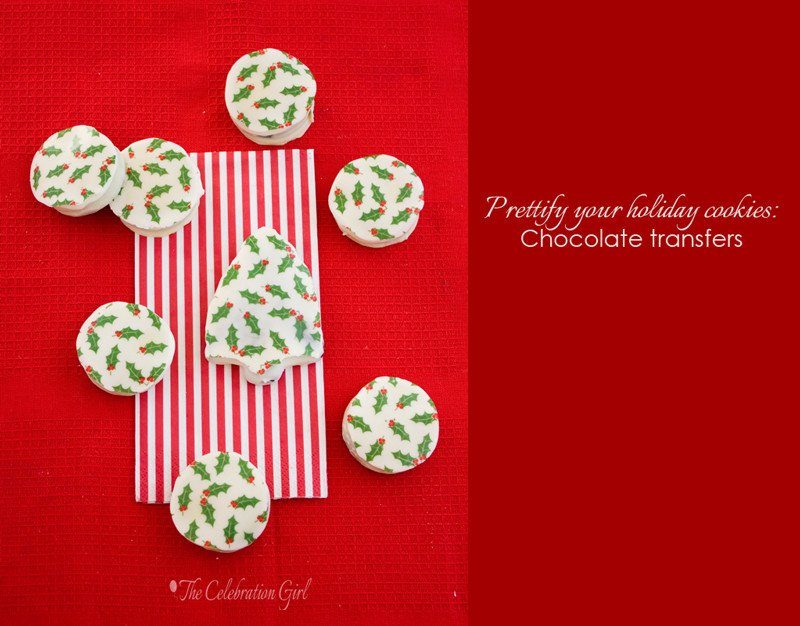
Good morning friends! Day 13 of the advent and the last of this year’s post about cookie decorating! I know some of you were expecting tutorials on royal icing, but I decided to leave those for next year, when we can dedicate several posts to different techniques. For those of you who would like to decorate cookies with royal icing and would like to know where to start, you may check THIS and THIS post, where I list links and resources as well.
Today’s technique is one that I had been curious about for quite a while, but had never tried before. When browsing party websites, I used to see those beautiful designer oreo cookies, and wondered how they made them, until I discovered that chocolate transfer sheets existed, and that I could buy them in Cyprus (tip for Cyprus residents: I got these at Sprinkles and Sparkles*). This is the first time I used one, so there’s definitely a lot of room for improvement, but they are really easy to use! I love how fast it is to decorate cookies with them, how pretty they look once finished, and also the fact that they represent and alternative to royal icing (which not everyone likes).
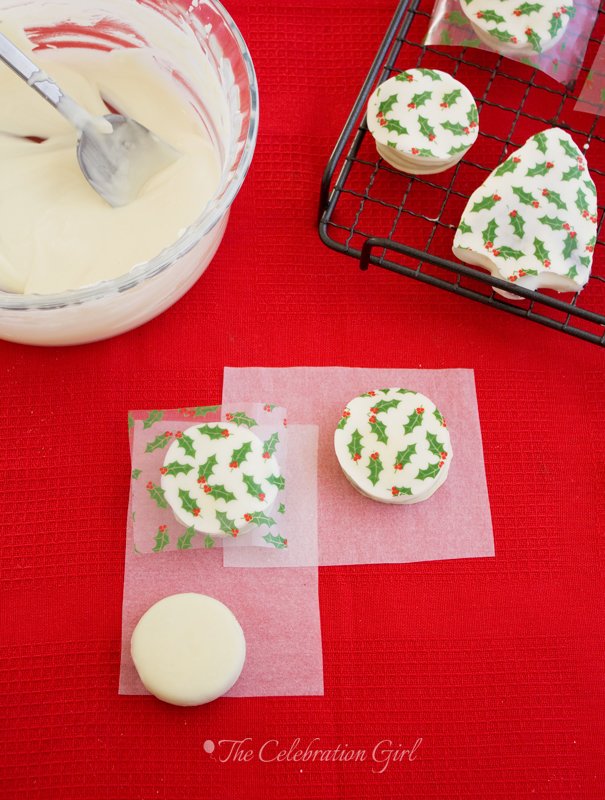
I dipped two types of cookies, for experimentation purposes: chocolate covered oreos and a pine tree chocolate cookie. Bird, from Bird’s party, made a tutorial showing how to create a really perfect finish for oreos that are not already covered in chocolate and which you can check HERE. The method I use is more appropriate for cookies that have a shape other than circular.
Here it is:
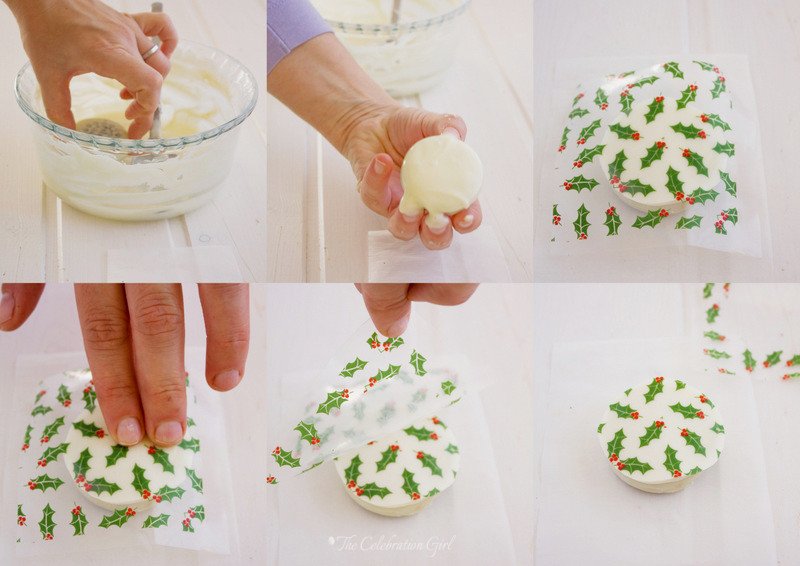
1) Melt the chocolate and cut the transfer sheet (which comes in A4 size) to match the size of the cookies. I cut stripes and the cut those stripes into small squares.
2) Holding the cookie in your hand, invert it and dip it in the chocolate, front-side down. Dip it well.
3) Lift the cookie, invert it so that the excess chocolate drips, and tap your hand against the counter a couple of times, so that the surface becomes smooth and even.
4) Put the cookie on a wire rack or parchment paper and place the transfer sheet on top of it.
5) Using your fingers, smooth the sheet, especially the sides, so as to make sure that it adheres properly to the chocolate, and to get rid of any air bubbles.Let the chocolate set and harden (about an hour. You can also accelerate the process by putting then in the refrigerator)
6) Carefully, lift the transfer sheet to reveal the design. Smooth the sides, if necessary.
That is all it takes! Isn’t it wonderful? Beautifully decorated cookies in virtually no time!
Have you used this method before? Would you like to try it?
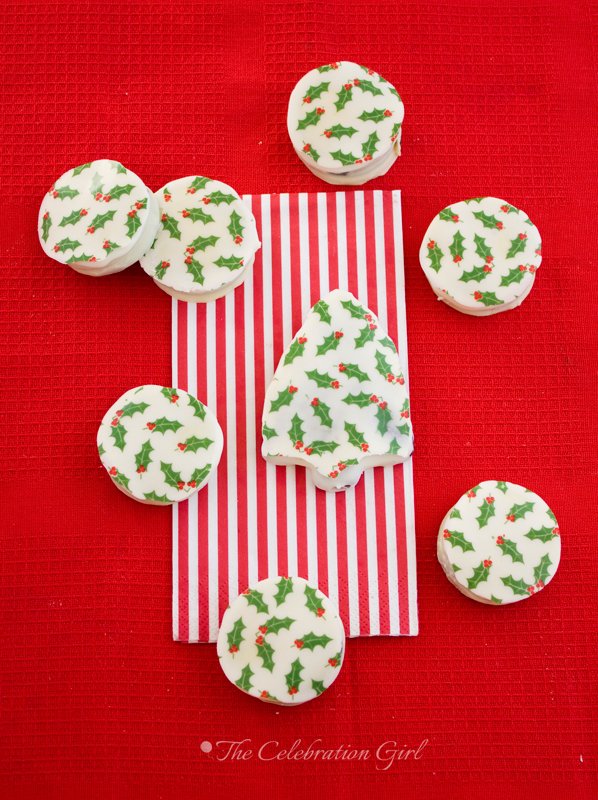
Con sabor latino…
Buenos días queridos amigos! Día 13 del adviento, y hoy nos toca el último tutorial sobre cómo decorar galletitas para las fiestas. Sé que varios de ustedes estaban esperando tutoriales acerca de cómo decorar galletitas con glacé real, pero decidí dejar los mismos para el año que viene, cuando pueda dedicar varios posts a mostrarles diferentes técnicas. Para aquellos que quieran decorar galletitas de esa forma en estos días, pueden ver ESTE y ESTE post, donde además de enseñar técnicas básicas, adjunto links y recursos que pueden encontrar online.
La tecnica de hoy es una que tenía ganas de probar desde hacía tiempo. Cuando miraba páginas dedicadas a fiestas siempre veía esas oreos preciosas, con diseños complicados y me preguntaba cómo los lograban. Luego, un día, aprendí que existían las llamadas láminas de transferencia de chocolate y que hasta podía conseguirlas en Chipre! Esta es la primera vez que uso una, así que se imaginarán que hay mucho que mejorar, pero me han resultado super faciles y me encanta el resultado tan bonito y tan rápido que dan, así como que sean una alternativa al glacé que, convengamos, no le gusta a todo el mundo.
Yo hice la impresión en dos tipos de galletitas; oreos ya bañadas en chocolate blanco (compradas), y unas cookies de chocolate con forma de pino de navidad. Bird, de Bird’s party, hizo un tutorial muy bueno hace unos días acerca de cómo bañar oreos comunes y hacer la impresión al mismo tiempo, para que queden perfectas. Pueden ver ese tutorial AQUI. La tecnica que yo usé es más apropiada cuando queremos hacer la transferencia en una galletita de forma diferente o tamaño más grande.
Para hacerlas, sigan estos pasos:
1) Derritan el chocolate. Corten la hoja de transferencia (que viene en tamaño A4) del tamaño de las galletitas. Yo la corté en tiras horizontales, que luego dividí en pequeños cuadrados.
2) Tomen la galletita con la mano, inviertanla y sumerjanla cara abajo en el chocolate. Asegurense que quede bien impregnada.
3) Con la galletita aun en su mano, inviertanla para que el exceso de chocolate comience a deslizarse por el borde y golpeteen el canto de la mano contra la mesa, para que se empareje y alise.
4) Coloquen la galletita sobre una rejilla o papel manteca y pongan la hoja de transferencia sobre la misma.
5) Usando la yema de los dedos, alisen la hoja de transferencia, especialmente en los bordes, para asegurarse que ésta se adhiera correctamente al chocolate, y que no queden burbujas de aire. Dejen que el chocolate se enfríe y endurezca (aproximadamente una hora, o pueden acelerar el proceso colocando las galletitas en la heladera)
6) Una vez que el chocolate haya endurecido y con mucho cuidado, despeguen la hoja de transferencia, levantandola por un costado. Emparejen los costados, de ser necesario.
Y listo, nada más, eso es todo lo que lleva hacerlas! No es maravilloso? Galletitas decoradas de manera bonita y en nada de tiempo!
Han usado este método antes? Les gustaría probarlo?
*I have no affiliation whatsoever to Sprinkles and Sparkles. The reason I mentioned where I got the transfer sheets is as a service to my readers, and only because people have asked me before where to buy them. You may also get them online from HERE
by Marcela M. | Dec 11, 2012 | Blog, Christmas and NYE, cookies, Cooking basics and tutorials, Holidays, Recipe Box, Recipes, Sweets

Good evening dear friends! Today, on day 11 of the advent, we continue decorating cookies, this time with a star ingredient: chocolate!
I love, love, loooove chocolate and I almost everyone I know also does, so I thought that it would be a good idea to include a mini section on super easy chocolate decorations. These are all very simple ways to spice up your cookies, that do not require anything more than a heat proof bowl for melting the chocolate, and a spoon. If you have a cooling rack to let the chocolate drip, so much the better, but if you don’t, you will still be able to make these cookies.
Working with chocolate can be tricky and the key is to melt it properly so as to achieve the right texture, and so as to make it last. It is important not to overheat it, or you will end up with something more similar to cookie dough than fluid, beautiful chocolate, and you should be particularly careful about this when working with white chocolate which, in my experience, can be quite moody.
Start by chopping the chocolate into small chunks and putting them in a heat proof bowl. Place the bowl over a saucepan containing a small amount of water, and bring it to low heat. The bowl should not touch the water, we just want the steam to melt the chocolate. Let the first pieces start to melt, shake the bowl a little bit and, when about 50% of it has melted, remove the bowl from the heat and mix with a wooden spoon. The remaining chocolate will melt when mixing. The reason I don’t let all chocolate melt over the heat is that it runs the risk of overheating (it has happened to me before). Once all chocolate is melted, continue mixing vigorously until it’s fluid and easy to work with.
Now that your chocolate is melted, let’s begin playing with those cookies!

You will need: dark chocolate, white chocolate and for some variations, ground nuts (I used almonds). You could also use chocolate/candy food coloring in case you want to add some more variety to the mix. Note that candy/chocolate coloring is different from general gel food coloring:it contains even less water, so as not to spoil the chocolate’s texture.Make sure that you are using the right kind!
Here are the versions I did:
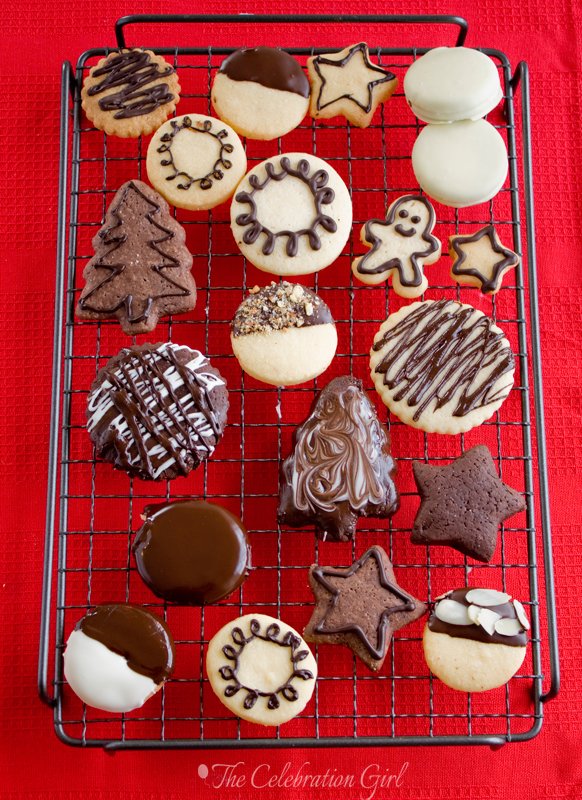
1) Full coverage: The first, most obvious option, is to fully cover the cookies in chocolate, either black or white. You can cover single or sandwich cookies, they both taste delicious. When you are covering your cookies fully, it is better to use a wire rack, because it allows the excess chocolate to drip, without creating a mess at the bottom. Simply pour a spoon or two of chocolate over the cookie, tap the rack against the counter a couple of times (so that the chocolate distributes evenly and there are no air bubbles) and let it drip and dry.

2) Half covered: This is an option that I like, not only because of how it looks, but also because the chocolate does not hide the cookie’s other flavors. It is very easy to do, as you can see from the pictures above: hold the cookie vertically, above the bowl of melted chocolate and, with a spoon or spatula, drop chocolate over the lower part of the cookie. Shake it slightly, so that the excess chocolate drips and then place it on a wire rack to finish drying.
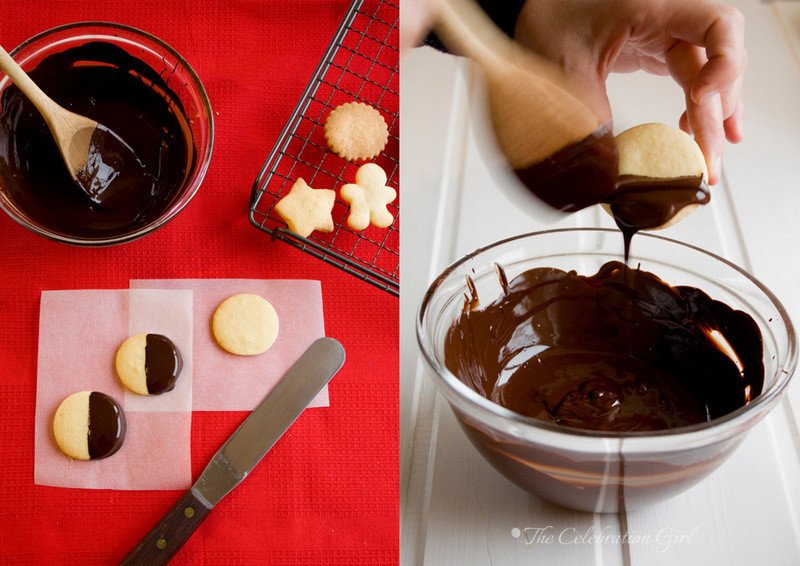
3) Half covered, with nuts: Pour crushed nuts of your choice, or slivered almonds over the chocolate, right after placing the cookies on the wire rack. Let it dry. This is a delicious option for shortbread cookies!
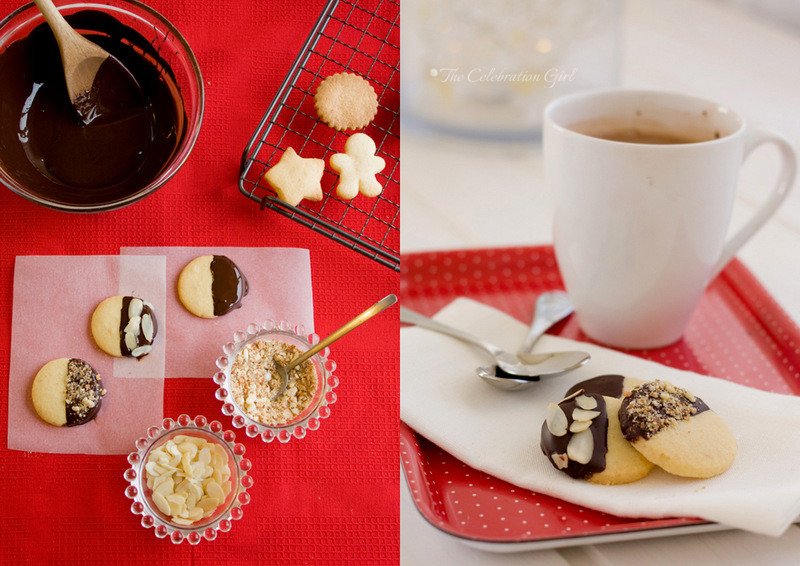
4) White and dark chocolate covered cookies: Another easy variation of the above, this time using both types of chocolate. Proceed to cover one side of the cookie, as shown in point 2 above, and let it dry. Once dry, cover the other half with the other chocolate. Let dry.
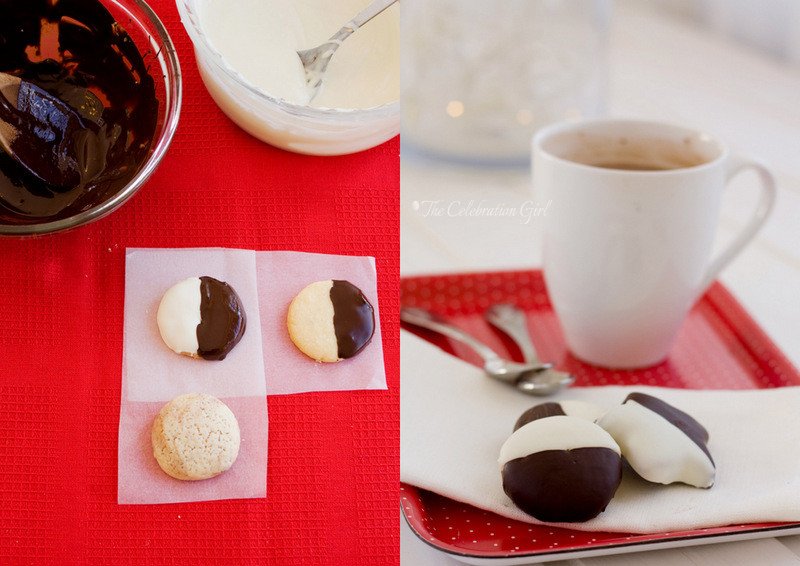
5) Marbled chocolate cookies: Cover the cookie completely with one color of chocolate and then, before it sets, add drops of the other chocolate here and there and immediately draw over them with a toothpick, moving your hand back and forth between the two chocolates.

6) Piped chocolate cookies: In order to make this design, you will need a disposable piping bag or a paper cornet. If you want to know how to make a paper cornet to pipe chocolate, you can check THIS video from Dyane Bakes, which is great.
Melt the chocolate and, once it reaches the appropriate texture, introduce a few spoons inside a cornet or piping bag. Cut a small aperture at the bottom of it and draw as with a pencil brush. You will need to work fast because the chocolate may harden inside the piping bag quite fast. If this happens, put the piping bag under running warm water until it melts again.
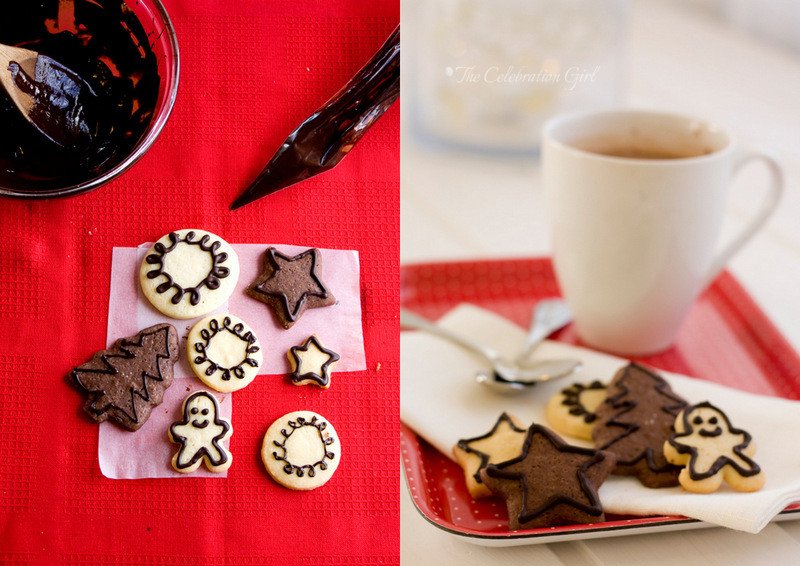
7) Chocolate stripes: Easy breezy. Hold the cookie over the bowl of melted chocolate, dip a spoon in it, let it drip until the stream of chocolate becomes thin and drizzle the cookie, moving your hand fast back and forth. Repeat with another color if you so desire.
Do you like these ideas? Which type of chocolate is your favorite?

Con sabor latino…
Buenas noches queridos amigos! Hoy, en el 11avo día del adviento vamos a seguir decorando galletitas, esta vez con un ingrediente estrella: el chocolate!
Amo, amo aaaaaaaaamo el chocolate, especialmente el bien amargo, y la mayoría de la gente que conozco tambien es fanática del mismo, así que pensé que podría ser una buena idea incluir una mini sección con decoraciones chocolatosas. Todas estas son formas muy sencillas de cambiar un poco sus galletitas, que requieren como todo instrumental un bowl resistente al calor para derretir el chocolate, y una cuchara. Si tienen una rejilla sobre la cual bañar las galletitas, es mejor porque ésta permita que el chocolate corra sin apelotonarse debajo, pero si no tienen una, tranquilos que tambien puede hacerse sólo quedará un poco menos prolijo).
Trabajar con chocolate tiene sus bemoles, pero la clave está en derretirlo correctamente y asegurarnos de templarlo bien antes de comenzar, para que tenga la textura adecuada y para que se deslice correctamente. Es muy importante no sobrecalentarlo, porque de hacerlo así terminaremos con un masacote más parecido a masa de galletas que a chocolate derretido! Tengan cuidado especialmente al trabajar con chocolate blanco, ya que en mi experiencia, es bastante temperamental.
Comiencen por cortar en trozos pequeños el chocolate y coloquenlos en un bowl resistente al calor. Luego, coloquen agua en una olla pequeña, y luego pongan el bowl sobre la misma, asegurándose que éste no toque el agua (sólo queremos que el vapor derrita el chocolate). Lleven la olla a fuego mínimo y,cuando el chocolate comience a derretirse,agitenla un poco para que el calor se distribuya. Cuando se haya derretido un 50% aproximadamente, retiren la olla del fuego y comiencen a mezclar vigorosamente. El chocolate restante se derretirá al entrar en contacto con el que ya está derretido, a medida que mezclamos. La razon por la que yo no dejo que todo el chocolate se derrita con la olla al fuego es que así se corre el riesgo de sobrecalentarlo, y arruinarlo (me ha pasado!). Una vez que todo el chocolate se ha derretido, continuen mezclando hasta que adquiera una textura fluida, con la cual sea facil trabajar.
Ahora que ya tienen listo su chocolate, empecemos a jugar con las galletitas!
Para hacer las galletitas que les mostraré a continuación necesitarán chocolate amargo o semi amargo y chocolate blanco y, para algunas, tambien nueces picadas a elección (yo usé almendras). Tambien pueden teñir el chocolate blanco con colorante, para añadir variedad, pero tengan en cuenta que los colorantes de chocolate no son los mismos que los de otras preparaciones, porque tienen que tener menor contenido de agua para no estropearlo. Asegurense de usar el colorante correcto si quieren teñir su chocolate!
He aquí las galletitas que hice en esta ocasión:
1) Galletitas totalmente bañadas en chocolate: Esta es la opción más obvia y sencilla.Pueden bañarse así galletas individuales o alfajorcitos, con cualquier chocolate. Ambas opciones son deliciosas. Cuando cubran sus galletitas completamente,tengan en cuenta que es mejor usar una rejilla para que el chocolate extra pueda gotear sin crear un pegotero en la base de la galletita. Para hacerlas, coloquen las galletitas sobre una rejilla, viertan una cucharada o dos de chocolate, golpeteen un par de veces la rejilla contra la mesada para que el chocolate se distribuya bien y no haya burbujas de aire, y dejen secar un par de horas.
2) Galletitas bañadas por la mitad: Esta opcion me encanta, no sólo por cómo luce sino tambien porque evitamos que el chocolate tape los aromas de las galletitas (sobre todo el negro, que puede ser invasivo). Hacerlas es muy sencillo: tomen la galletita y coloquenla de manera vertical sobre el bowl de chocolate. Con una cuchara o espatula, viertan chocolate sobre la mitad de la galletita, sacudanla un poco para que caiga el exceso y coloquenla sobre una rejilla para dejarla secar.
3) Galletitas bañadas por la mitad, con nueces: Espolvoreen nueces molidas a elección sobre la mitad cubierta de chocolate antes que se seque.Tambien pueden usar almendras fileteadas. Esta opcion es deliciosa con las galletitas de manteca.
4) Galletitas bicolor: Otra variante sencilla de la número 2. La clave está en hacer un lado primero, dejar que se seque, y luego bañar la otra mitad con el otro color.
5) Galletitas marmoladas: Bañen completamente la galletita con un chocolate y, una vez totalmente cubierta, agreguen gotas del otro chocolate en diversos lugares. Finalmente, dibujen diseños con un palillo escarbadiente, mezclando los chocolates, moviendo la mano en forma de 8.
6) Galletitas con contorno de chocolate: Para hacer este diseño necesitarán una manga descartable o hacer un cono de papel como el que indican en este video. Derritan el chocolate y, una vez que haya alcanzado el temple, coloquen un par de cucharadas dentro del cono o manga y dibujen como lo harian con un pincel. Tengan en cuenta que deberán trabajar rápidamente porque de lo contrario el chocolate se endurecerá dentro de la manga. Si les ocurre esto último, coloquen la manga bajo un chorro de agua caliente. Si usan un cono de papel deberan sacar los restos de chocolate seco del mismo y derretirlo nuevamente.
7) Galletitas con rayas de chocolate: Facilísimas. Tomen la galletita y sostenganla con una mano sobre el bowl con chocolate. Sumerjan una cuchara en el mismo, elevenla, dejando que el chocolate corra hasta que el hilo sea fino y una vez que así sea, dibujen rayas de chocolate, moviendo la mano de izquierda a derecha rápidamente. Repitan con el otro chocolate si asi lo desean.
¿Les gustan estas ideas? ¿Cuál es su sabor de chocolate preferido?
by Marcela M. | Dec 7, 2012 | Blog, Christmas and NYE, cookies, Holidays, Recipe Box, Recipes, Sweets
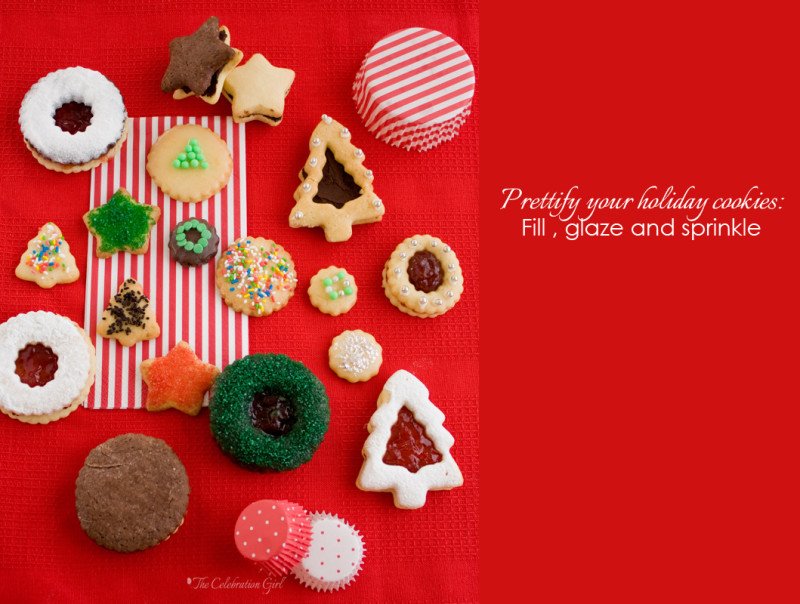
Good morning dear friends! 18 days until Christmas!
Now that you have made your cookie dough, baked them in different shapes and prepared your fillings and glazes, let’s play with them and add some more cookies to your assorted cookie box! You may also want to get sprinkles, non pareils, sanding sugar, blanched slivered almonds, crushed nuts, funfetti and any other decoration of your liking.
Ready? Ok, let’s begin. And remember: these are just a few ideas to spark your imagination. I am sure that, when you start playing with whatever you have in hand, you will find many more options!
1) Sandwich cookies: The easiest idea is to sandwich two cookies of the same size and shape with a filling of your choice. In my previous post, I gave you the recipe for a chocolate cream that tastes particularly delicious with the almond shortbread cookies, but you could also use nutella, vanilla cream, lemon curd, or jams and marmalades, such as orange, strawberry, or raspberry, for example.

2) Combined sandwich cookies: This idea is a simple variation of the first one: combine the cookie flavors when sandwiching them. Different cookie recipes also have different textures and,when combined, they offer different taste experiences. You could combine, for example, a chocolate sugar cookie with an almond shortbread cookie, filling it with nutella; or join an orange sugar cookie with a vanilla sugar cookie, and sandwich them with lemon curd; or sandwich a lemon and an orange sugar cookie with raspberry or strawberry jam (the tart flavor of the citrus combines beautifully with the sweetness of the berries). Again, play around until you find your own favorites!
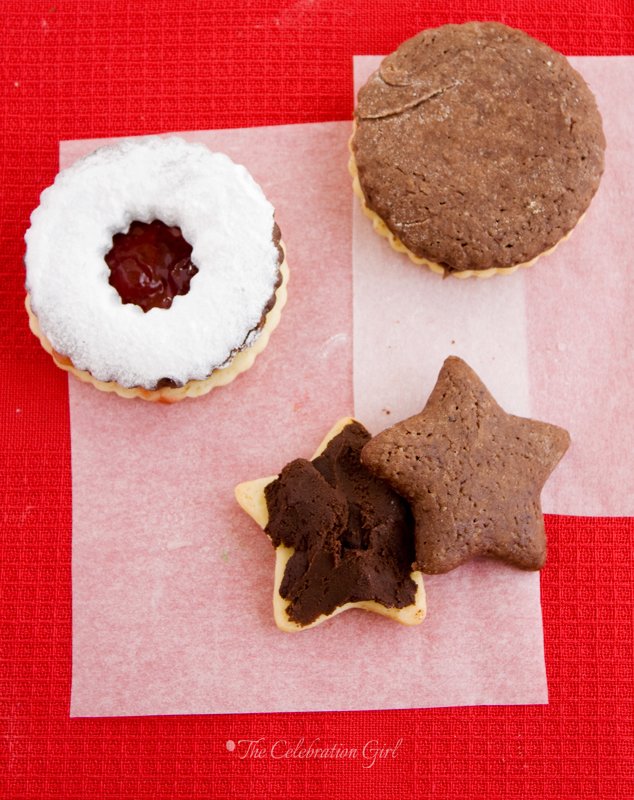
3) Linzer cookies: These look so pretty, don’t you think? They are two cookies, sandwiched with strawberry or raspberry jam, with the peculiarity that the top cookie has a cutout that reveals the jam, and has been sprinkled with confectioner’s sugar prior to sandwiching it (if you sprinkle the sugar after, it will cover the jam as well and the effect will be lost).
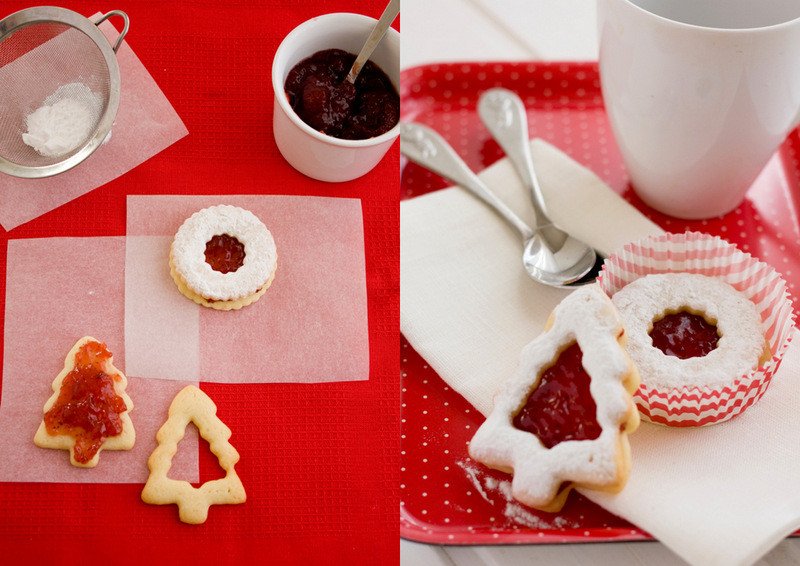
4) Linzer cookies, decorated with sugar pearls (instead of confectioner’s sugar): This is a sparkly twist on the traditional linzer cookies and, as you can see from the pictures, I changed the traditional filling as well, and used chocolate cream instead of jam in one of the cookies. In order to attach the sugar pearls you can use royal icing (home made or pre made as the one in the picture), or sugar glue.
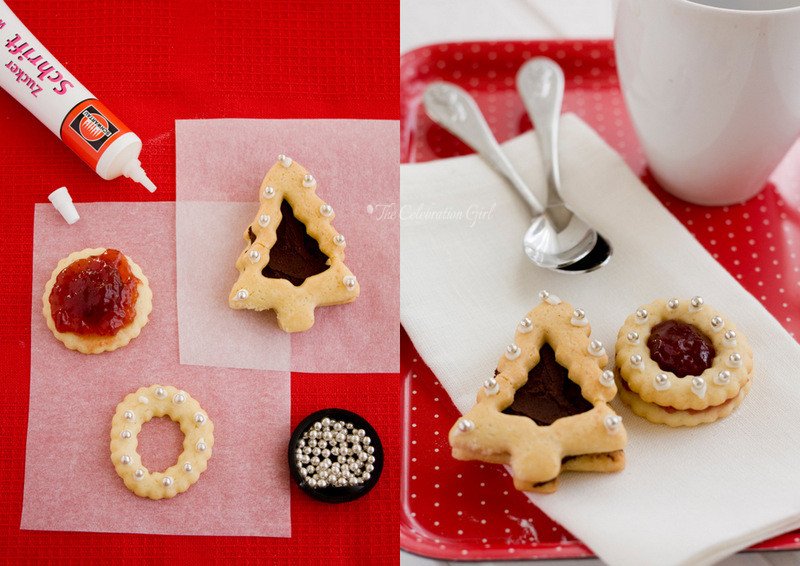
5) Lemon, orange or sugar glazed cookies: If you are thinking what to do with all the mini cookies you got left, after making linzer cookies, this is a good solution that also maximizes every bit of dough and saves you time. Place your cookies on a wire rack, pour one tablespoon of the glaze of your choice over each of them (Lemon glaze is my favourite) and let it set. You could also move your spoon back and forth, quickly, when pouring the glaze, to create stripes of glaze instead of giving the cookies of full coverage.
6) Glazed cookies, decorated with sprinkles: This is a variation of the ones above. Place your cookies on a wire rack, pour one tablespoon of the glaze of your choice over each of them and immediately spread a few sprinkles over them. I used the ones I have, but red and green ones would look adorable and appropriate for this season. Let the glaze set.

7) Glazed cookies, decorated with sanding sugar: Another easy variation to use with glaze.Just as before, place your cookies on a wire rack, pour one tablespoon of the glaze of your choice over each of them and immediately spread sanding sugar over them. Let the glaze set and then lift the cookies and shake them to remove the excess sugar.
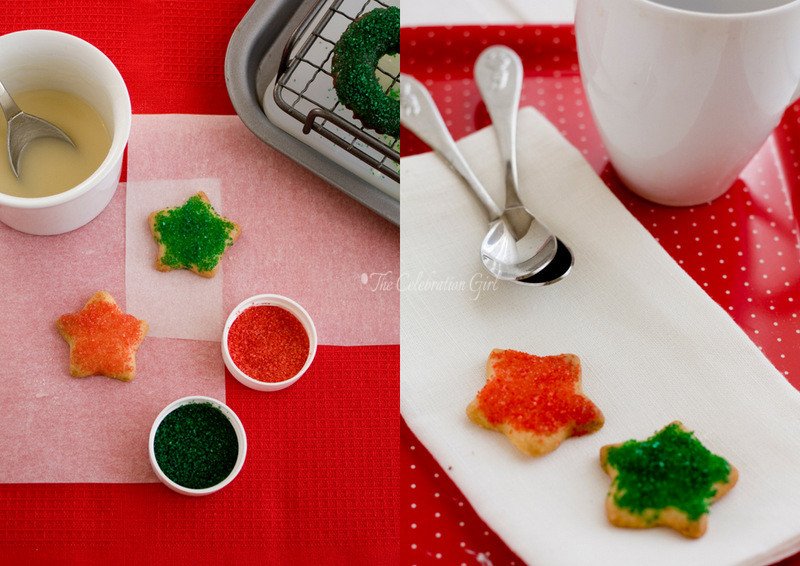
8) Linzer cookies, glazed and decorated with sanding sugar: This option would look particularly pretty with a Christmas tree shaped linzer cookie, but I thought about it too late (he). In order to make it, fill the bottom cookie with jam or other filling, as it is traditional but, instead of sprinkling the top cookie with confectioner’s sugar, put it on a wire rack, glaze it and add sanding sugar to it (as in the cookies above). The result will be a sparkly, crunchy linzer cookie that the kids will love!

9) Lemon glazed sugar cookies, with Christmas designs made with sprinkles and funfetti: Finally, here is a way to let out the little artist in you and/or play with the kids. Take all your sugar decorations out , pour the glaze of your choice over the cookies, and have fun creating Christmas shapes. I made a tree and a couple of wreaths but you could also make elf hats, stockings, stars…anything!
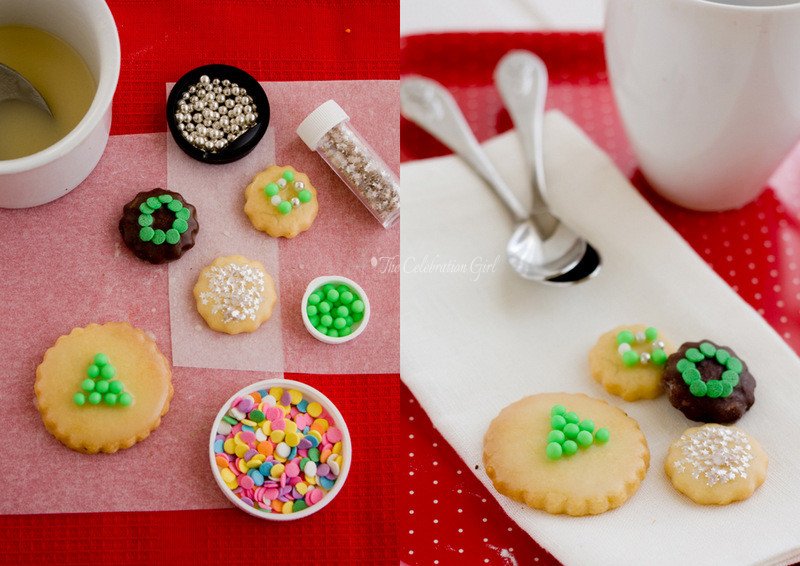
Have fun decorating cookies! And make some extra dough, because there are more ideas to come!
Con sabor latino…
Buenos días queridos amigos! Faltan sólo 18 días para la navidad!
Ahora que ya han preparado la masa de sus galletitas, las han horneado con formas diferentes, y tienen los rellenos y glaseados listos, es hora de comenzar a jugar con todos estos elementos y ampliar la variedad de nuestras cajas de galletitas surtidas. Preparen todos los ingredientes, y busquen todas las granas, azucares, perlas, non pareils, nueces, funfetti y demas decoraciones que anden dando vuelta por sus casas, porque vamos a darles buen uso!
Listos? Comenzamos! Las ideas que les voy a mostrar a continuación son sólo algunas de las tantas posibilidades que existen…cuando empiecen a jugar con sus materiales y dejen volar su imaginación seguramente crearán muchas otras combinaciones diferentes!
Estas son mis opciones:
1) Galletas rellenas: La idea más sencilla de todas, sin, dudas, es la de unir dos galletitas de la misma forma y tamaño con un relleno que nos guste. La idea me gusta más con galletitas en miniatura, quedan más delicadas, pero eso es cuestión de gustos. En mi post anterior compartí la receta de una crema de chocolate que es ideal para combinar con las galletitas de almendra, pero tambien pueden usar otros rellenos, como nutella, crema de vainilla, lemon curd, o bien mermeladas y jaleas de naranja, frutilla o frambuesa, entre otras.
2) Galletas rellenas combinadas: Una variante simple de la opción anterior es combinar los sabores de las galletitas que uniremos con relleno. Por otra parte, diferentes recetas otorgan galletitas con textura diferente y, cuando las combinamos, ofrecen una experiencia gustativa diferente. Algunas combinaciones que me gustan mucho son, entre otras: galletita de chocolate y de almendras con relleno de nutella, galletita de naranja y vainilla con relleno de lemon curd, o galletita de limon y galletita de naranja con relleno de frambuesas o frutillas (la acidez de los citricos combina deliciosamente con la dulzura de las fresas y frutos del bosque). Jueguen hasta encontrar sus favoritas!
3) Galletitas Linzer: Son tan bonitas, no les parece? Se trata de dos galletitas, unidas con mermelada de frambuesa o frutilla, que tienen la peculiaridad de que la galletita superior está ahuecada, dejando ver el relleno, y ha sido espolvoreada con azucar impalpable antes de unir. Es necesario espolvorearla con azucar antes de unirla porque, si lo hacemos despues, el azucar cubrirá la mermelada y se perderá el efecto tradicional.
4) Galletitas Linzer, decoradas con perlas de azucar en lugar de azucar impalpable: Una variación para darle un poco de brillo a las Linzer tradicionales. Noten tambien que, en esta ocasión, tambien jugué con los rellenos y me tomé la libertad de colocar crema de chocolate en una de las galletitas. Las perlas de azucar pueden pegarse a la galletita con glacé real (casero o envasado), o bien con pegamento de azucar (sugar glue).
5) Glaseado de limón, naranja o azúcar: Esta es una buena solución para todas aquellas mini galletitas que les quedaron despues de ahuecar las que usaron para hacer las linzer, y asi ampliar de manera eficiente la variedad de su cajita de galletas surtidas. Coloquen la galletita en una rejilla y viertansobre la misma el glaseado que más les guste ( el de limon es mi preferido) y dejenlo secar. Tambien pueden glasearlas moviendo la cuchara hacia delante y hacia atrás, rápidamente, para crear un efecto zebra.
6) Galletitas glaseadas y decoradas con granas de colores: Una variación de la opción anterior. Coloquen la galletita en una rejilla, viertan sobre la misma el glaseado que más les guste e, inmediatamente despues, espolvoreen granas de colores. Yo usé las que tenía en casa, pero una combinación de granas verdes y rojas se vería preciosa y apropiada para esta época. Dejen secar el glaseado
7) Galletitas glaseadas y decoradas con azucar de colores: Coloquen la galletita en una rejilla y viertan sobre la misma el glaseado que más les guste e, inmediatamente, espolvoreen azucar de colores encima. Dejen secar el glaseaso y luego levanten la galletita con cuidado, y agitenla un poquito, para dejar caer el azúcar extra.
8)Galletitas linzer, glaseadas y decoradas con azucar de colores: Esta opción es ideal para las galletitas linzer con forma de arbolito de navidad pero se me ocurrió demasiado tarde (je). Para hacerla, rellenen la galletita de abajo de la manera tradicional pero, en lugar de espolvorear la galletita superior con azucar impalplable, colóquenla en una rejilla, viertan el glaseado deseado y luego espolvoreen azucar de colores sobre el mismo. El resultado será una galletita linzer brillante y crujiente que los niños adorarán!
9) Galletitas con glaseado de limón, y diseños hechos con granas y perlas de azucar. Finalmente, les dejo una opción para sacar su artista interior y/o jugar con los niños. Tomen todas sus decoraciones de azucar, coloquen la galletita ahuecada en una rejilla y viertan sobre la misma el glaseado que más les guste y luego diviertanse dibujando formitas navideñas con granas, perlas, funfetti y demás. Yo hice un arbolito y varias coronas, a modo de ejemplo, pero tambien pueden hacerse bastoncitos, gorros de elfo, medias navideñas, estrellas…prácticamente cualquier cosa!
Espero que se diviertan muchísimo decorando sus galletitas! Y guarden masa o hagan de más, porque la semana que viene llegarán más ideas todavía!



































